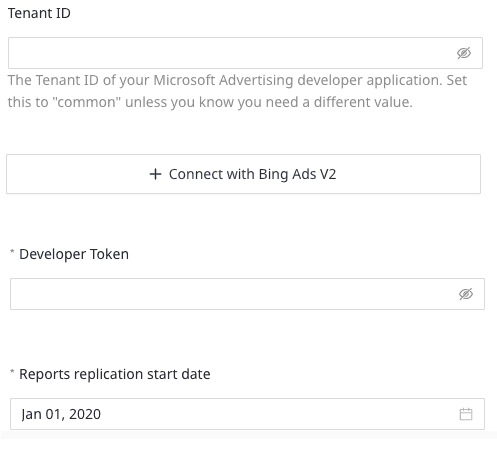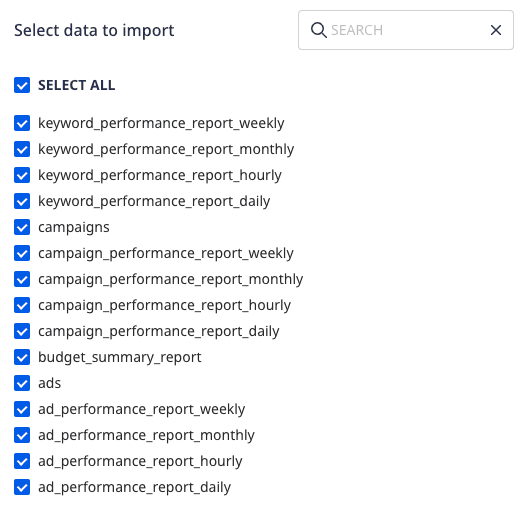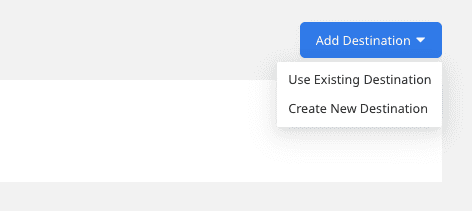Bing Ads is a pay per click (PPC) advertising platform that works on both Bing and Yahoo search engines. It allows marketers to track and monitor their ad campaigns, resulting clicks, CTRs, and more.

Getting Started
- Log into your RudderStack dashboard.
- Go to Sources > New source > Cloud Extract and select Bing Ads V2 from the list of sources.
- Assign a name to your source and click Continue.
Connection settings
Next, configure the following dashboard settings:

- Tenant ID: Enter the Tenant ID of your Microsoft Advertising developer application. It is recommended to set it as
commonunless you need a different value. - Connect with Bing Ads V2: Click this button to give RudderStack the required permissions to access your Bing Ads account.
- Developer Token: Enter your user developer token. Refer to the Microsoft documentation for more information on obtaining the developer token.
- Reports replication start date: Select the date from when RudderStack should ingest your Bing Ads data. RudderStack will not replicate any data before this date.
Destination settings
The following settings specify how RudderStack sends the data ingested from Bing Ads to the connected warehouse destination:
- Table prefix: RudderStack uses this prefix to create a table in your data warehouse and loads all your Bing Ads data into it.
- Schedule Settings: RudderStack gives you three options to ingest the data from Bing Ads:
- Basic: Runs the syncs at the specified time interval.
- CRON: Runs the syncs based on the user-defined CRON expression.
- Manual: You are required to run the syncs manually.
Selecting the data to import
You can choose the Bing Ads data you want to ingest by selecting the required resources:

The below table mentions the syncs and primary keys supported by these resources from Bing Ads to your warehouse destination:
| Resource | Sync type | Primary key |
|---|---|---|
Account Performance Report | Incremental | AccountId, TimePeriod, CurrencyCode, AdDistribution, DeviceType, Network, DeliveredMatchType, DeviceOS, TopVsOther, BidMatchType |
Accounts | Full Refresh | Id |
Ad Group Performance Report | Incremental | AccountId, CampaignId, AdGroupId, TimePeriod, CurrencyCode, AdDistribution, DeviceType, Network, DeliveredMatchType, DeviceOS, TopVsOther, BidMatchType, Language |
Ad Groups | Full Refresh | Id |
Ad Performance Report | Incremental | AccountId , CampaignId, AdGroupId, AdId, TimePeriod, CurrencyCode, AdDistribution, DeviceType, Language, Network, DeviceOS, TopVsOther, BidMatchType, DeliveredMatchType |
Ads | Full Refresh | Id |
Budget Summary Report | Incremental | Date |
Campaign Performance Report | Full Refresh | AccountId, CampaignId, TimePeriod, CurrencyCode, AdDistribution, DeviceType, Network, DeliveredMatchType, DeviceOS, TopVsOther, BidMatchType |
Campaigns | Full Refresh | Id |
Keyword Performance Report | Incremental | AccountId, CampaignId, AdGroupId, KeywordId, AdId, TimePeriod, CurrencyCode, DeliveredMatchType, AdDistribution, DeviceType, Language, Network, DeviceOS, TopVsOther, BidMatchType |
Bing Ads is now configured as a source. RudderStack will start ingesting data from Bing Ads as per your specified schedule and frequency.
You can further connect this source to your data warehouse by clicking on Add Destination, as shown:

FAQ
Is it possible to have multiple Cloud Extract sources writing to the same schema?
Yes, it is.
We have implemented a feature wherein RudderStack associates a table prefix for every Cloud Extract source writing to a warehouse schema. This way, multiple Cloud Extract sources can write to the same schema with different table prefixes.
Contact us
For more information on the topics covered on this page, email us or start a conversation in our Slack community.